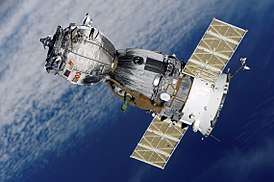Soyuz TM-25
Soyuz TM-25 was the 30th crewed spacecraft mission to visit the Russian Space Station Mir.[1]
| Operator | Rosaviakosmos |
|---|---|
| COSPAR ID | 1997-003A |
| SATCAT no. | 24717 |
| Mission duration | 184 days, 22 hours, 7 minutes, 40 seconds |
| Orbits completed | ~2,950 |
| Spacecraft properties | |
| Spacecraft type | Soyuz-TM |
| Manufacturer | RKK Energia |
| Launch mass | 7,150 kilograms (15,760 lb) |
| Crew | |
| Crew size | 3 up 2 down |
| Members | Vasili Tsibliyev Aleksandr Lazutkin |
| Launching | Reinhold Ewald |
| Callsign | Си́риус (Sirius) |
| Start of mission | |
| Launch date | February 10, 1997, 14:09:30 UTC |
| Rocket | Soyuz-U |
| End of mission | |
| Landing date | August 14, 1997, 12:17:10 UTC |
| Landing site | 170 kilometres (110 mi) SE of Dzhezkazgan |
| Orbital parameters | |
| Reference system | Geocentric |
| Regime | Low Earth |
| Perigee altitude | 378 kilometres (235 mi) |
| Apogee altitude | 394 kilometres (245 mi) |
| Inclination | 51.56 degrees |
| Docking with Mir | |
 Soyuz programme (Crewed missions) | |
Crew
| Position | Launching crew | Landing crew |
|---|---|---|
| Commander | Second and last spaceflight | |
| Flight Engineer | Only spaceflight | |
| Research Cosmonaut | Only spaceflight |
None |
Mission highlights
This was the 30th expedition to Mir. An ESA astronaut from Germany was included on the mission.
Soyuz TM-25 is a Russian spacecraft that was launched to carry astronauts and supplies to Mir station. It was launched by a Soyuz-U rocket from Baykonur cosmodrome at 14:09 UT to ferry three cosmonauts for a 162-day stay at the station; it docked with the station at 15:51 UT on 12 February 97. Within meters of automatic approach to the station, a slight misalignment was noted, and the commander of the module had to dock it by manual steering.
gollark: But what if you want to be able to SSH into your ceiling lamps, ħmmmmm?
gollark: You could use an ESP32 thingy, yes.
gollark: I don't know. They might. Do not trust companies to keep running the backend without a subscription payment.
gollark: Plus it won't randomly break when Philips inevitably discontinues stuff.
gollark: THINK OF THE PROGRAMMERS who have to deal with random clock jumps and stuff (although sane applications will use UTC internally, I think Windows actually is stupid and sets the clock to *local time*, thus problems).
References
- The mission report is available here: http://www.spacefacts.de/mission/english/soyuz-TM-25.htm
This article is issued from Wikipedia. The text is licensed under Creative Commons - Attribution - Sharealike. Additional terms may apply for the media files.

